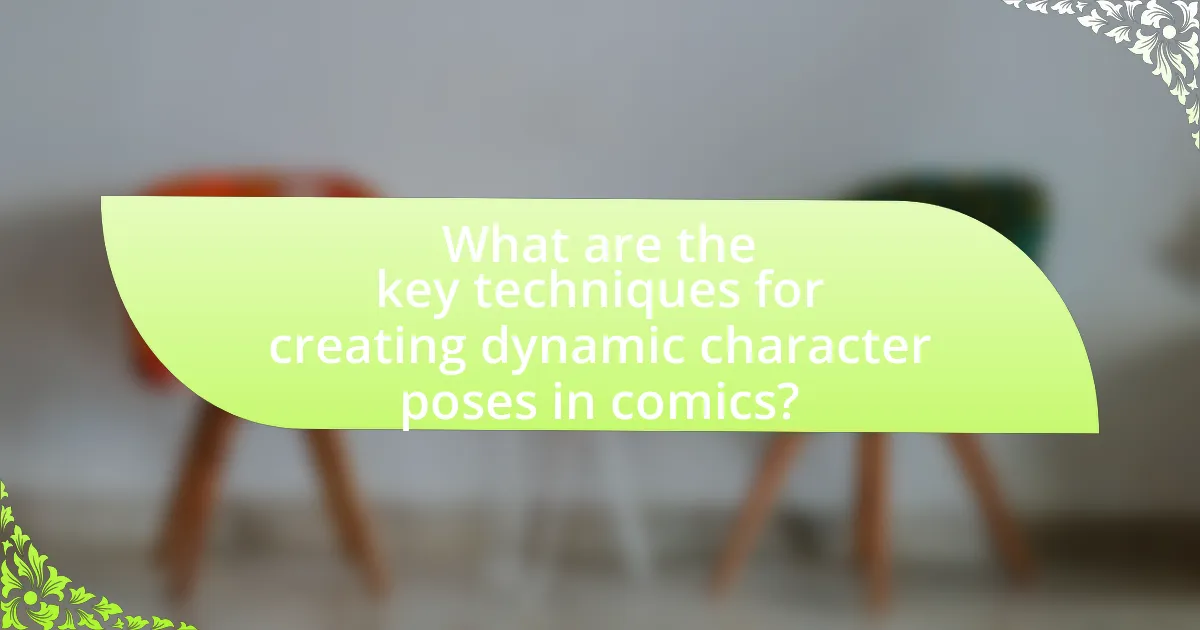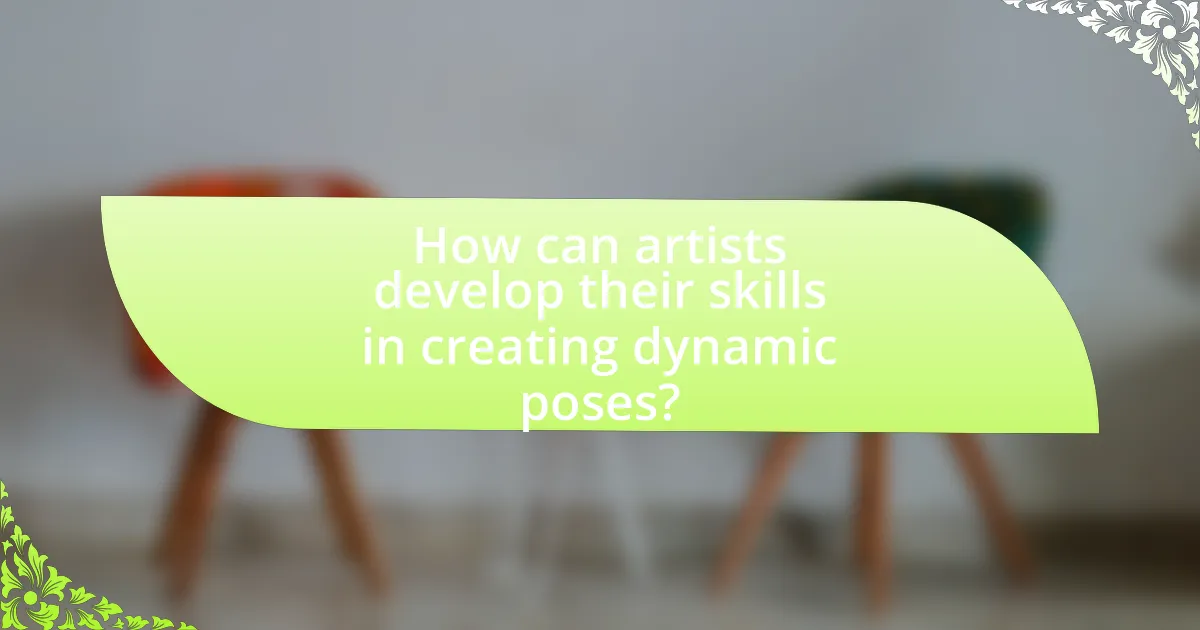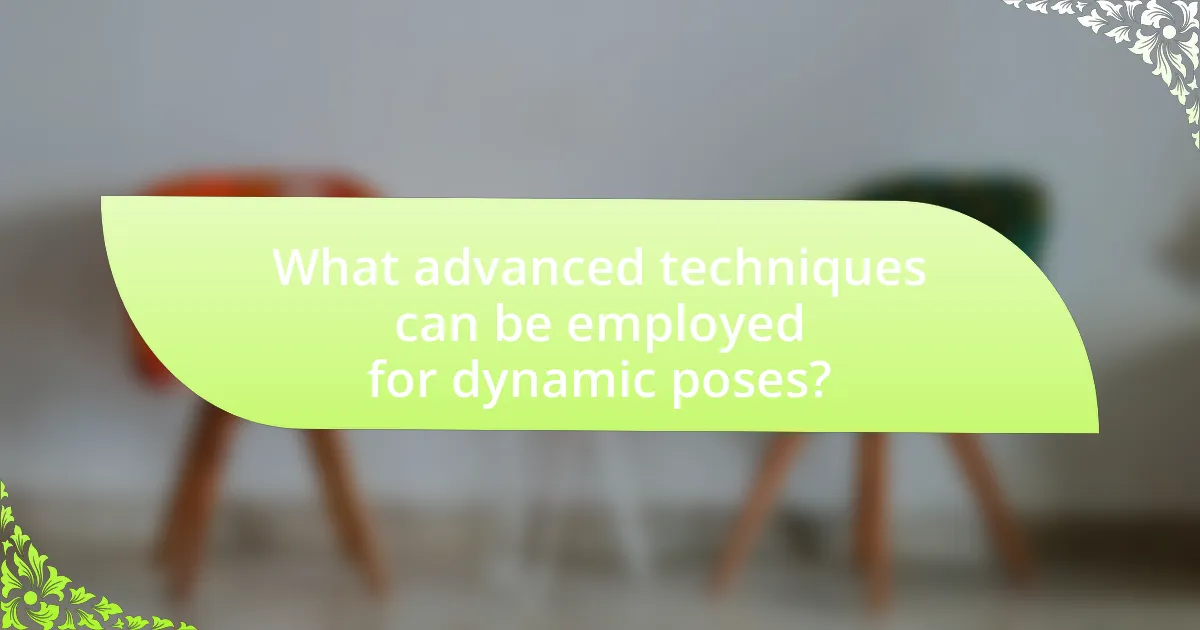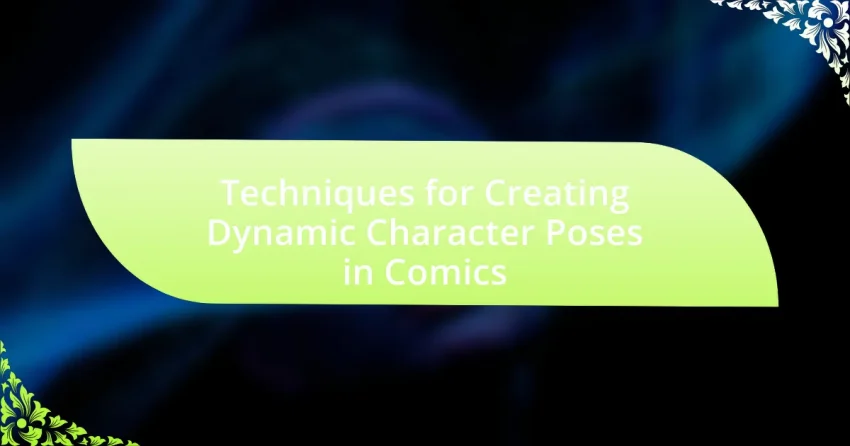The article focuses on techniques for creating dynamic character poses in comics, emphasizing the importance of exaggerated proportions, strong lines of action, and foreshortening. It explores how dynamic poses enhance storytelling by conveying emotion, action, and character personality, while also discussing foundational principles such as balance, movement, and exaggeration. Additionally, the article addresses common mistakes to avoid, the significance of body language, and advanced techniques like perspective and foreshortening. It provides practical advice for artists on developing their skills through gesture drawing, studying anatomy, and utilizing digital tools for pose refinement.

What are the key techniques for creating dynamic character poses in comics?
The key techniques for creating dynamic character poses in comics include using exaggerated proportions, employing strong lines of action, and incorporating foreshortening. Exaggerated proportions enhance the visual impact of poses, making characters appear more dynamic and engaging. Strong lines of action guide the viewer’s eye and create a sense of movement, while foreshortening adds depth and realism by depicting objects or limbs as shorter when viewed from a distance. These techniques are widely recognized in comic art, as they effectively convey energy and emotion, making scenes more compelling.
How do dynamic poses enhance storytelling in comics?
Dynamic poses enhance storytelling in comics by conveying emotion, action, and character personality more effectively than static poses. These poses allow artists to illustrate movement and tension, which can heighten the drama of a scene. For example, a character in a dynamic pose, such as leaping or twisting, can visually communicate urgency or conflict, engaging the reader’s attention and drawing them into the narrative. Research indicates that dynamic compositions can increase reader immersion, as they create a sense of flow and rhythm that mirrors the pacing of the story.
What role do character poses play in conveying emotions?
Character poses play a crucial role in conveying emotions by visually representing a character’s feelings and state of mind. These poses can communicate a wide range of emotions, such as happiness, sadness, anger, or fear, through body language, posture, and facial expressions. For instance, an open and relaxed pose may indicate confidence or joy, while a hunched or closed-off posture can suggest insecurity or distress. Research in visual communication shows that body language accounts for a significant portion of emotional expression, with studies indicating that up to 93% of communication effectiveness can be attributed to nonverbal cues, including posture and gestures. Thus, effective character poses are essential for enhancing emotional storytelling in comics.
How can poses influence the pacing of a comic narrative?
Poses can significantly influence the pacing of a comic narrative by conveying action, emotion, and tension. Dynamic poses can accelerate the pacing by suggesting movement and urgency, while static poses can slow down the narrative, allowing for reflection or emotional depth. For example, a character in a dramatic pose, such as lunging forward, creates a sense of immediacy, prompting readers to move quickly through the panels. Conversely, a character in a contemplative pose, like sitting with their head down, encourages readers to linger on the moment, thus slowing the pace. This relationship between poses and pacing is essential for guiding the reader’s experience and emotional response throughout the comic.
What are the foundational principles of dynamic poses?
The foundational principles of dynamic poses include balance, movement, and exaggeration. Balance ensures that the character appears stable while in motion, allowing for a believable representation of weight distribution. Movement captures the essence of action, conveying energy and direction through body language and limb positioning. Exaggeration enhances the visual impact of the pose, emphasizing key features and actions to create a more engaging and dynamic representation. These principles are essential in comic art to effectively communicate the character’s emotions and actions to the audience.
What is the significance of balance and weight in character poses?
Balance and weight in character poses are crucial for conveying realism and emotional impact. Proper balance ensures that a character appears stable and grounded, while weight gives the impression of mass and physical presence. For instance, a character leaning forward suggests eagerness or aggression, while a character slumping may indicate defeat or fatigue. These elements help artists communicate the character’s state of mind and intentions effectively. Studies in animation and figure drawing emphasize that understanding the principles of balance and weight can significantly enhance the believability of poses, making them more engaging for the audience.
How does the line of action contribute to pose dynamism?
The line of action significantly contributes to pose dynamism by establishing a clear direction and flow within a character’s pose. This line acts as an invisible guide that enhances the sense of movement and energy, making the pose appear more alive and engaging. For instance, in dynamic poses, the line of action often curves or angles sharply, which can suggest motion and tension, thereby drawing the viewer’s eye along the path of action. This technique is widely utilized in comic art, where artists like Jack Kirby and Jim Lee have effectively employed the line of action to create visually striking and dynamic character poses, demonstrating its importance in conveying action and emotion.
What common mistakes should be avoided when creating poses?
Common mistakes to avoid when creating poses include neglecting body language, failing to consider balance, and overlooking the character’s personality. Neglecting body language can lead to static or unconvincing poses, as effective poses should convey emotion and action. Failing to consider balance may result in unrealistic stances that do not support the character’s weight distribution, making the pose appear awkward. Overlooking the character’s personality can lead to poses that do not align with their traits or story context, diminishing the impact of the visual narrative. These mistakes can detract from the overall effectiveness of character representation in comics.
How can stiffness in poses detract from character expression?
Stiffness in poses can significantly detract from character expression by limiting the range of motion and emotional conveyance. When characters are depicted in rigid positions, it restricts their ability to communicate feelings such as joy, anger, or sadness, which are often expressed through subtle body language and fluid movements. Research in visual storytelling indicates that dynamic poses enhance emotional engagement; for instance, a study by McCloud in “Understanding Comics” emphasizes that movement and posture are crucial for conveying narrative and emotion. Therefore, stiff poses can result in a lack of relatability and emotional depth, ultimately diminishing the impact of the character within the comic.
What are the pitfalls of over-exaggeration in poses?
Over-exaggeration in poses can lead to a loss of realism and relatability in character design. When poses are excessively exaggerated, they may appear unnatural, making it difficult for the audience to connect with the characters. This disconnect can detract from the storytelling, as viewers may focus more on the unrealistic aspects rather than the narrative itself. Additionally, over-exaggerated poses can create visual clutter, overwhelming the reader and obscuring the intended action or emotion. Research in visual perception indicates that clarity is essential for effective communication in art; thus, maintaining a balance between dynamism and realism is crucial for engaging storytelling in comics.

How can artists develop their skills in creating dynamic poses?
Artists can develop their skills in creating dynamic poses by studying human anatomy and movement. Understanding the structure of the human body allows artists to accurately depict how muscles and joints function during various actions. Additionally, practicing gesture drawing, which involves quick sketches of live models, helps artists capture the essence of movement and fluidity. Research indicates that artists who engage in regular life drawing sessions improve their ability to represent dynamic poses effectively, as evidenced by studies showing enhanced observational skills and spatial awareness. Furthermore, analyzing the work of established artists and utilizing reference materials can provide insights into effective pose dynamics, reinforcing the learning process.
What exercises can help improve pose creation skills?
To improve pose creation skills, artists can practice gesture drawing, which involves quickly sketching the human figure in various poses to capture movement and form. This exercise enhances understanding of anatomy and fluidity, allowing artists to create more dynamic and expressive poses. Studies show that regular gesture drawing sessions can significantly increase an artist’s ability to depict action and emotion in their work, as it trains the eye to recognize and replicate the subtleties of human movement. Additionally, using reference photos or live models can provide concrete examples of poses, further aiding in the development of pose creation skills.
How does gesture drawing aid in understanding movement?
Gesture drawing aids in understanding movement by capturing the essence and flow of a pose in a short time frame. This technique emphasizes the dynamic lines and shapes that represent the body’s motion, allowing artists to visualize and convey action effectively. Studies in art education show that gesture drawing enhances an artist’s ability to depict movement by training them to observe and interpret the physicality of figures quickly, which is crucial for creating dynamic character poses in comics.
What role does studying anatomy play in pose development?
Studying anatomy is crucial in pose development as it provides a foundational understanding of the human body’s structure and movement. This knowledge enables artists to create realistic and dynamic poses that accurately reflect how muscles, bones, and joints interact during various actions. For instance, understanding the skeletal system allows artists to depict correct limb positioning and balance, while knowledge of muscle groups aids in illustrating tension and relaxation in poses. This anatomical insight is supported by studies in figure drawing, which emphasize that artists who grasp anatomical principles produce more lifelike and expressive characters, enhancing the overall quality of comic art.
How can reference materials be utilized effectively?
Reference materials can be utilized effectively by providing visual and contextual guidance that enhances the accuracy and dynamism of character poses in comics. Artists can study anatomy, movement, and expressions from reference images to create more realistic and engaging characters. For instance, using photographs of real people in various poses allows artists to understand the subtleties of body language and perspective, which can lead to more compelling storytelling. Additionally, referencing established comic styles can help maintain consistency in character design and pose execution, ensuring that the artwork aligns with the intended narrative tone.
What types of references are most beneficial for pose creation?
Photographic references are most beneficial for pose creation. They provide accurate depictions of human anatomy, movement, and expressions, which are essential for creating realistic and dynamic character poses in comics. Studies in figure drawing emphasize the importance of using photographs to understand proportions and foreshortening, as they capture real-life scenarios that can be translated into artistic representations. Additionally, utilizing references from various angles enhances the artist’s ability to depict depth and perspective, making the poses more engaging and lifelike.
How can artists analyze poses from existing comics or media?
Artists can analyze poses from existing comics or media by studying the composition, anatomy, and movement depicted in the artwork. This involves closely observing how characters are positioned, the angles of their limbs, and the overall balance of the pose. For instance, artists can break down poses into basic shapes to understand the underlying structure, which aids in replicating or innovating upon those poses. Additionally, referencing dynamic poses from well-known comics, such as those by artists like Jack Kirby or Jim Lee, provides concrete examples of effective pose dynamics. Analyzing these poses can reveal techniques such as foreshortening, perspective, and the use of line of action, which are essential for creating engaging character representations.

What advanced techniques can be employed for dynamic poses?
Advanced techniques for dynamic poses include the use of foreshortening, exaggerated perspectives, and action lines. Foreshortening allows artists to create depth by depicting objects or limbs as shorter than they are in reality, enhancing the illusion of three-dimensionality. Exaggerated perspectives can amplify the sense of movement and energy, making poses appear more dynamic. Action lines, which are visual cues that indicate motion, guide the viewer’s eye and emphasize the direction of movement. These techniques are widely recognized in comic art, as they effectively convey action and emotion, making characters more engaging and lifelike.
How can perspective enhance the impact of character poses?
Perspective enhances the impact of character poses by altering the viewer’s perception of depth and spatial relationships, making poses appear more dynamic and engaging. When artists employ techniques such as foreshortening or varying the angle of view, they create a sense of three-dimensionality that draws the audience into the scene. For instance, a character posed in a dramatic low angle can convey power and dominance, while a high angle can suggest vulnerability. This manipulation of perspective not only emphasizes the emotional state of the character but also enhances the overall storytelling by visually guiding the viewer’s focus. Studies in visual perception indicate that perspective can significantly affect how viewers interpret action and emotion in art, reinforcing the importance of this technique in comic creation.
What are the effects of foreshortening in dynamic poses?
Foreshortening in dynamic poses creates a sense of depth and movement, enhancing the visual impact of the character. This technique allows parts of the body that are closer to the viewer to appear larger, while those further away appear smaller, effectively conveying action and perspective. For instance, in comic art, when a character reaches forward, the arm may be drawn significantly larger than the torso, emphasizing the motion and drawing the viewer’s eye along the action. This visual distortion not only adds realism but also engages the audience by making the scene more dynamic and immersive.
How can background elements interact with character poses?
Background elements can enhance character poses by providing context, depth, and emotional resonance. For instance, a character posed in a dynamic action stance can be complemented by background elements like tilted buildings or swirling clouds, which convey movement and urgency. This interaction creates a cohesive visual narrative, making the scene more engaging. Research in visual storytelling indicates that backgrounds can influence viewer perception, as seen in studies on composition and focus, where elements like perspective and color contrast significantly affect how characters are interpreted within their environments.
What digital tools can assist in creating dynamic poses?
Digital tools that assist in creating dynamic poses include software like Adobe Photoshop, Clip Studio Paint, and Procreate. These applications provide features such as customizable brushes, layering options, and 3D model integration, which enable artists to experiment with various angles and perspectives. For instance, Clip Studio Paint offers a 3D pose tool that allows users to manipulate virtual models to achieve desired poses, enhancing the accuracy and dynamism of character illustrations. Additionally, tools like Blender can be used for 3D modeling and animation, providing a comprehensive approach to visualizing complex poses in a three-dimensional space.
How can 3D modeling software aid in pose experimentation?
3D modeling software aids in pose experimentation by allowing artists to manipulate digital models in a virtual space, enabling them to explore various angles, positions, and expressions quickly. This software provides tools for adjusting limb positions, body angles, and facial expressions, which can be rendered in real-time, facilitating immediate visual feedback. For instance, programs like Blender and Maya offer rigging systems that allow for the easy adjustment of character poses, making it possible to experiment with dynamic movements and stances that enhance storytelling in comics. Additionally, the ability to save and modify poses helps artists refine their work efficiently, ensuring that the final character poses are both dynamic and visually appealing.
What are the benefits of using digital sketching tools for pose refinement?
Digital sketching tools enhance pose refinement by providing flexibility, precision, and immediate feedback. These tools allow artists to easily manipulate and adjust poses, enabling rapid iterations that improve the overall quality of character design. For instance, features like layers and undo options facilitate experimentation without the risk of losing previous work. Additionally, digital sketching tools often include grids and perspective guides, which help maintain accurate proportions and angles, crucial for dynamic poses. Studies have shown that artists using digital tools can increase their productivity by up to 30%, as they can quickly test and modify poses compared to traditional methods.
What are some best practices for creating dynamic poses in comics?
To create dynamic poses in comics, artists should focus on exaggeration, perspective, and fluidity. Exaggeration enhances the emotional impact and action of a pose, making characters appear more expressive and engaging. Perspective, such as using foreshortening, adds depth and realism, drawing the reader’s eye into the scene. Fluidity ensures that poses convey motion and energy, making the action feel alive. These techniques are supported by studies in visual storytelling, which emphasize that dynamic poses can significantly enhance reader engagement and narrative clarity.
How can artists maintain consistency in character poses throughout a comic?
Artists can maintain consistency in character poses throughout a comic by creating a character model sheet that outlines key poses and proportions. This model sheet serves as a reference for artists, ensuring that characters are depicted with the same physical attributes and stylistic elements across different panels. Additionally, artists can utilize a grid system or guidelines to maintain spatial consistency, which helps in aligning characters within the comic’s environment. Studies in visual storytelling emphasize that consistent character design enhances reader engagement and comprehension, as it allows for a seamless narrative flow.
What tips can help artists convey action and movement effectively?
To effectively convey action and movement, artists should utilize dynamic poses, strong lines of action, and appropriate use of perspective. Dynamic poses capture the essence of movement by showcasing the character’s body in a way that suggests motion, such as bending limbs or twisting torsos. Strong lines of action create a visual flow that guides the viewer’s eye through the composition, enhancing the sense of energy. Additionally, employing perspective techniques, such as foreshortening, can amplify the feeling of depth and speed, making the action more impactful. These methods are supported by studies in visual perception, which indicate that viewers respond more strongly to images that depict clear motion and dynamic forms.
